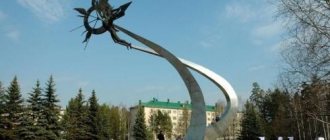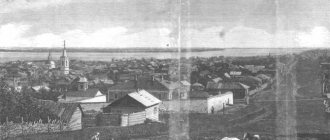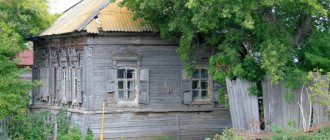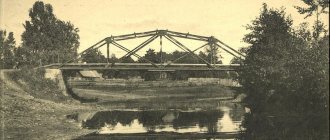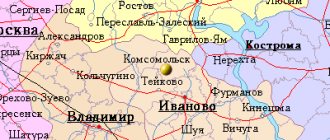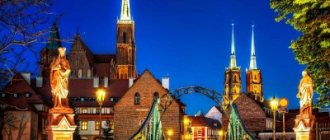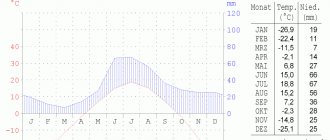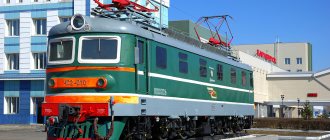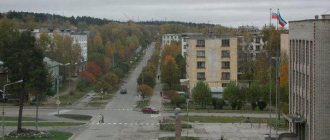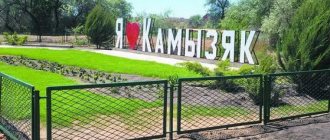You can see more about the districts of the Saratov region here.
Arkadak is a small town in the Saratov region, a regional center. It lies on the Bolshoy Arkadak River. The names of both geographical objects, according to historians, come from the Turkic words “area surrounded by mountains.”
But there is also a version that connects the origin of the place with the Greek Bosphorus Kingdom. The name of the city, according to it, comes from two Greek words: “arch” and “dak”, abbreviated “dakryon”, which translates as spring water as clear as a tear.
City coat of arms
The draft coat of arms of Arkadak was developed by the Commission on Heraldry under the Governor of the Saratov Region in 1997-1998 and was finally approved with general approval on April 15. 1998. The description created by leading heraldists says about it like this:
“In gold, standing on the green tip is a scarlet (red) elk. In the left free part there is the coat of arms of the Saratov region (three silver sterlets placed in a fork-shaped cross, facing in an azure field."
The coat of arms attracts attention with sharp color contrasts, recalling the interesting history of the city.
Infrastructure[ | ]
The city is built mainly with one-story wooden houses, although there are many private brick houses and urban five-story buildings with apartments. The regional infrastructure has been developed, since the city of Arkadak is the center of the Arkadak district of the Saratov region of the Russian Federation. There is a recreation park, the Khoper hotel, 3 schools, 5 kindergartens, the district administration, the House of Culture, the Mir cinema, the Cosmos cinema, the Elegant House of Public Services, the House of Pioneers (sports sections and clubs), a sports stadium , workshops, shops, market, Russian post office, pharmacies, police department, prosecutor's office, court, branches of Sberbank of Russia, a sports and recreation complex (with a swimming pool, with halls for gymnastics and games, weightlifting), a center for social assistance to families and children “Family”, etc.
In 2011, two bridges were put into operation, across the Khoper River (162 meters) and the Khopra oxbow lake “Gnilusha” (155 meters) for the new highway through Arkadak (along the Saratov-Turki route). There is a bus station and a gas station.
Population
Now Arkadak is not distinguished by its large population; in 2018, only 11,895 people lived here.
Now, out of 1,113 cities in Russia, it ranks 863rd in terms of population.
Most of the residents are of mixed origin. So, in 1721, only local residents lived here, natives of the Volga region and descendants of peasants who fled central Russia during the period of strengthening of serfdom.
In 1736, Naryshkin brought here 313 peasants from Murom and Serpukhov villages, then Orthodox Ukrainians were added to them.
A little later, in the 19th century, a colony of Germans and Danes, supporters of Protestantism, was formed here.
Pacifist Mennonites moved to Russia since the invitation of Catherine II; in 1854 in Arkadak they were allocated land in the amount of 15 dessiatines per capita.
By the beginning of the 20th century, the settlement included 8 separate villages with a mixed German-Danish population, which amounted to about 1,500 people; after the resettlement of Volga Germans in 1941, the villages were liquidated.
Now the townspeople live mainly in private wooden houses, but in some areas five-story panel buildings have been built.
Modern brick cottages are being built. In 2006, Arkadak was recognized as the third most comfortable settlement in the Saratov region among all regional cities belonging to category 3.
Arkadak
origin of name
The territory where the current city of Arkadak is located was inhabited in the past by Turkic nomadic peoples. Most likely, they gave the name to the Arkadak River, from which the city later received its name. This hydronym was probably obtained by combining the Turkic words “arch” (long, elongated hill), “ada” (island) and “ak” (white). According to another version, the name is deciphered from Turkic as “back mountain” (behind the river in the hills). Another version suggests that the name has Greek roots and may mean “bend of water.”
Village in the 18th – early 20th centuries.
In 1691, the Khopyor lands were granted by royal decree to Lev Kirillovich Naryshkin, Peter I’s uncle.
For the first time the village of Arkadak is mentioned as a “new settlement
"under 1721 after the first census of the Russian Empire (1719–1727). It was founded by Alexander Lvovich Naryshkin, who inherited these lands from his father and resettled serfs from the Moscow, Tambov and Tula provinces to the left bank of the Arkadak River. In 1736, the settlement was expanded to include peasants resettled from Serpukhov and Murom estates. In the same year, A.L. Naryshkin built the first wooden church in Arkadak, consecrated in the name of St. Nicholas the Wonderworker. According to the church, the second name was assigned to the village - Nikolskoye.
The next owner of Arkadak was the Ukrainian hetman, Count Kirill Grigoryevich Razumovsky, who married in 1746 Ekaterina Naryshkina, who was brought up in the house of her uncle Alexander Lvovich and received Arkadak as a dowry. Razumovsky resettled Orthodox Ukrainians in the village.
The son of Kirill Grigorievich and Ekaterina Ivanovna, Andrei Kirillovich Razumovsky, in 1820 sold Arkadak to a large landowner Aggei Vasilyevich Abaza, who founded a “distillery” in the village that produced “bread wine” (vodka).
In the List of populated places of the Saratov province for 1859, Nikolskoye (Arkadak) is listed as a proprietary village of the Balashov district near the Arkadak river, 50 versts from the district town of Balashov. The village had 195 households, with 1,565 residents (780 men, 785 women), an Orthodox church, a distillery, and a bazaar.
The village was located on the road from Balashov to Serdobsk. In 1868, the Abaza estate was sold to Prince L.D. Vyazemsky. In the period from 1872 to 1881, he opened a school, hospital, and boarding house for poor children in the village. An estate and a distillery were established. At the end of the 19th century. A railway was built, on which the Arkadak station was opened in 1895, and industry began to develop. All this contributed to rapid population growth. The village was the administrative center of the Arkadak volost as part of the Balashov district of the Saratov province.
In 1900, a library was opened in Arkadak, in 1903 a Theological School was opened, and a brick building of the Zemstvo Hospital was built. In 1909 a brick factory was built.
As of 1910, there were 718 households in Arkadak, and the population was 3,648 inhabitants - 1,784 men and 1,864 women. There was a stone church, two schools, a hospital, and a postal and telegraph office. Markets were held on Mondays, and two annual fairs were held - May 9 and September 6–8. 1,560 acres of sown land were registered with the peasants in the village. More than half of the area was used for oats and millet; wheat, rye and sunflower were also sown. There were 115 iron plows available for all farms. In the village there were 599 heads of draft cattle, 480 dairy cattle, 474 gulling cattle, 12,587 small cattle. There were 21 shops and 9 inns.
In 1913, an elevator, a mill of the merchant A. N. Epifanov and an oil mill were built in Arkadak. During the First World War, the mill of the merchant Belyaev was built. Arkadak Mennonites opened a mechanical workshop in the village for the assembly and repair of agricultural implements and machines, an oil churn, a steam mill, and a tile production plant.
Soviet period
In March 1917, after the February Revolution, the Council of Workers' Deputies was formed in Arkadak. On November 19, 1917, Soviet power was proclaimed in the village. By April 1918, landowners' estates and enterprises were nationalized, and the first state farms were created. In 1919, a Komsomol organization was formed.
On July 31, 1919, a propaganda train arrived in Arkadak, and the chairman of the All-Russian Central Executive Committee, Mikhail Kalinin, gave a speech to the village residents, workers and peasants.
At the end of the 1920s. Active reorganization of the economy began in the village. July 23, 1928 Arkadak becomes the center of the newly formed Arkadak district of the Balashov district of the Lower Volga region. In 1929, the first machine and tractor station was created, in 1930 the first collective farm “Smychka” was formed, which later received a new name - “The Path to Communism”.
In 1939, the village of Arkadak received the status of a workers' village. In 1940, a two-story high school building was built in the village.
With the beginning of the Great Patriotic War, by July 3, 1941, 729 Arkadak residents submitted applications to the military registration and enlistment offices with a request to send them as volunteers to the front. About 12 thousand residents of the Arkadak region took part in the fighting during the war years, about half of the fighters died a heroic death. Fourteen natives of the district were awarded the title of Hero of the Soviet Union, many were awarded orders and medals. Evacuation hospital No. 3302 operated in Arkadak, and two orphanages operated. The main jobs were performed by women.
In the post-war years, the village actively developed. New industrial enterprises were launched, collective farms were expanded and improved. The center of the village was decorated with new administrative buildings, educational and cultural facilities. In 1956, a milk canning plant was built (now OJSC Arkadakkonservmoloko).
On February 1, 1963, the workers' village of Arkadak was given the status of a city. The population of the young city at that time exceeded 12,600 inhabitants.
In the 1960s streets were paved, up to 30 residential buildings were put into operation annually, construction in the city was carried out in accordance with the master plan. In 1964, the hotel opened and the new Zvezdochka kindergarten welcomed children. In 1965, a three-story building of a secondary school on Lev Tolstoy Street was put into operation. In July 1965, the Arkadak Medical School was founded, located in the pre-revolutionary building of the former pedagogical school on Kaplunova Street. In 1969, the fire station and department store buildings were built. In the 1970s The Beryozka restaurant was opened, a clinic and pharmacy, police and district executive committee buildings, and a bakery were built. The city was gasified.
In 1981, the printing house and editorial office of the newspaper “Selskaya Nov” began operating in a specially built building, and in 1982, the prosecutor’s office and court began operating. In 1985, the Elegant welfare center was opened on the main square, and a 4-story therapeutic department of the district hospital was put into operation. In 1987, the Sberbank building was built, in 1989 - a sports and recreation complex with a swimming pool, sports and gyms. According to data for 1989, the population of the city of Arkadak was 14,244 people.
Modern Arkadak is the smallest city in the Saratov region. The predominantly one-story buildings of the city give it a rather rural appearance. Just like a century and a half ago, the main enterprise of Arkadak today remains the distillery.
Culture
Arkadak is famous for its local history museum. It was opened in 1971 as a public one, by local historian Stepan Fedorovich Shishkanov, and in 1990 it was annexed to the Saratov Regional Museum of Local History and became its branch.
The area of the museum is 400 meters, on which collections telling about the life of the peasants and intelligentsia of the city are carefully stored. Among the most interesting exhibits are a mammoth tusk and a Sauromatian sword.
There are also finds from the burial mounds of the Arkadak Prikhopery region, in particular, fragments of ceramics decorated with a pattern in the form of the World Tree. It was depicted in the form of a Christmas tree. The second interesting ornament that will attract the attention of the researcher of the storerooms will be the image on the vessels of a serpent, which ancient artists painted in the form of a zigzag; such an ornament was found in the Alenkin Kurgan.
The attention of visitors is attracted by antique furniture, among which one can find the tables of the postmaster and the manager of the distillery, Count Naryshkin.
Separate exhibitions are dedicated to the Germans of the Volga region, the role of P.A. Stolypin in the history of the Saratov province, of which he was governor at one time, and famous cultural and artistic figures of the city.
Thus, N.N. Semenov, the greatest chemist of the 20th century, the creator of the general theory of chain chemical reactions and the modern theory of combustion and explosion processes, was born in Arkadak, elected, among other things, an honorary doctor of the University of Wroclaw and 7 other universities and a member of 13 academies Sci.
The famous surgeon S.I. also worked in Arkadak. Spasokukotsky. A separate exhibition is dedicated to the work of a native of the region, member of the Union of Artists, N.B. Shafeev. S.F. Shishkanova managed to prove that the sister of the famous Russian artist David Burliuk, Lyudmila Burliuk, lived in Arkadak at one time.
In addition to the museum, studios and creative clubs make a significant contribution to the culture of the city. The children's ensemble "Poteshki" and the folk groups "Rodnik" and "Rasseyushka" work and delight the city residents with their creativity. The main information resource of the district is the online publication “Selskaya Nov”.
Climate[ | ]
The climate is temperate continental with uniform but insufficient moisture.
Climate of Arkadak (normal 1981–2010)
| Index | Jan. | Feb. | March | Apr. | May | June | July | Aug. | Sep. | Oct. | Nov. | Dec. | Year |
| Average temperature, °C | −8 | −8,5 | −3,2 | 7,3 | 14,5 | 18,7 | 20,7 | 19,1 | 13,2 | 6,1 | −1,5 | −6,7 | 6,0 |
| Precipitation rate | 37 | 30 | 30 | 29 | 38 | 58 | 54 | 41 | 47 | 41 | 45 | 39 | 489 |
| Source: [4]. | |||||||||||||
Attractions[ | ]
- The current Holy Ascension Church is made of brick (since 1822). According to legend, before the revolution, a cross with particles of the Holy Cross from Jerusalem was kept in the temple, which was used in the coronation ceremony of the Russian Emperors. In 1918 he disappeared without a trace.
- Monument to those killed in the Great Patriotic War on the central square; a monument to V.I. Lenin, also in 2022, a symbol of Culture of the Arkadak region was installed.
- Holy Ascension Church in Arkadak
- Arkadak Local Lore Museum
- Arkadak administration on the central square
- Arkadak House of Culture
- Arkadak House of Life "Elegant"
- Arkadak Sports Stadium
- Arkadak children's playground in the park
- Arkadak dance floor for a disco in the park
- Entrance hall of the old distillery (distillery producing stillage, the characteristic smell of Arkadak)
- The old bed of the Khoper River - the edge of Lake Gnilusha (on the road to the Khoper River)
Notes[ | ]
- ↑ 123
The permanent population of the Russian Federation by municipalities as of January 1, 2022 (Russian). Retrieved April 27, 2022. Archived May 2, 2022. - “Saratov ecumene” - “Arkadak”, I. Ya. Yakovleva oikumenesaratov.ucoz.ru
- The head of the Arkadak district administration has been appointed
- FSBI "VNIIGMI-MCD". Weather station "Rostashi".
- All-Union Population Census of 1939. The size of the urban population of the USSR by urban settlements and intra-city areas (unspecified)
. Retrieved November 30, 2013. Archived November 30, 2013. - All-Union Population Census of 1959. The size of the urban population of the RSFSR, its territorial units, urban settlements and urban areas by gender (Russian). Demoscope Weekly. Access date: September 25, 2013. Archived April 28, 2013.
- All-Union Population Census of 1970 The size of the urban population of the RSFSR, its territorial units, urban settlements and urban areas by gender. (Russian). Demoscope Weekly. Access date: September 25, 2013. Archived April 28, 2013.
- All-Union Population Census of 1979 The size of the urban population of the RSFSR, its territorial units, urban settlements and urban areas by gender. (Russian). Demoscope Weekly. Access date: September 25, 2013. Archived April 28, 2013.
- All-Union population census of 1989. Urban population (undefined)
. Archived from the original on August 22, 2011. - ↑ 12345678
People's encyclopedia "My City". Arkadak - All-Russian population census 2002. Volume. 1, table 4. Population of Russia, federal districts, constituent entities of the Russian Federation, districts, urban settlements, rural settlements - regional centers and rural settlements with a population of 3 thousand or more (unspecified)
. Archived from the original on February 3, 2012. - The size of the permanent population of the Russian Federation by cities, urban-type settlements and regions as of January 1, 2009 (unspecified)
. Retrieved January 2, 2014. Archived January 2, 2014. - All-Russian population census 2010. Number and distribution of the population of the Saratov region (unspecified)
. Retrieved July 6, 2014. Archived July 6, 2014. - Saratov region. Estimated resident population as of January 1, 2009-2015.
- Population of the Russian Federation by municipalities. Table 35. Estimated resident population as of January 1, 2012 (unspecified)
. Retrieved May 31, 2014. Archived May 31, 2014. - Population of the Russian Federation by municipalities as of January 1, 2013. - M.: Federal State Statistics Service Rosstat, 2013. - 528 p. (Table 33. Population of urban districts, municipal districts, urban and rural settlements, urban settlements, rural settlements) (undefined)
. Retrieved November 16, 2013. Archived November 16, 2013. - Table 33. Population of the Russian Federation by municipalities as of January 1, 2014 (unspecified)
. Access date: August 2, 2014. Archived August 2, 2014. - Population of the Russian Federation by municipalities as of January 1, 2015 (unspecified)
. Access date: August 6, 2015. Archived August 6, 2015. - Population of the Russian Federation by municipalities as of January 1, 2016 (Russian) (October 5, 2018). Retrieved May 15, 2022. Archived May 8, 2022.
- Population of the Russian Federation by municipalities as of January 1, 2022 (Russian) (July 31, 2017). Retrieved July 31, 2022. Archived July 31, 2022.
- Population of the Russian Federation by municipalities as of January 1, 2022 (Russian). Retrieved July 25, 2018. Archived July 26, 2022.
- Population of the Russian Federation by municipalities as of January 1, 2022 (Russian). Retrieved July 31, 2019. Archived May 2, 2022.
- Population of the Russian Federation by municipalities as of January 1, 2022 (Russian). Date accessed: October 17, 2022. Archived October 17, 2022.
- taking into account the cities of Crimea
- https://rosstat.gov.ru/storage/mediabank/bul_Chislen_nasel_MO-01-01-2021.rar Population of the Russian Federation by municipalities as of January 1, 2022 (1.85 Mb, 07/30/2021)
- Organizations and enterprises of the city of Arkadak and Arkadak region
